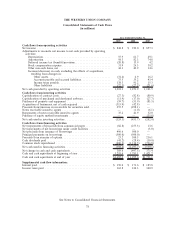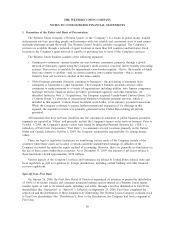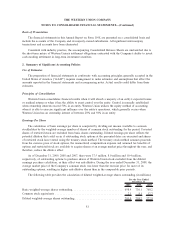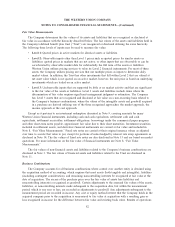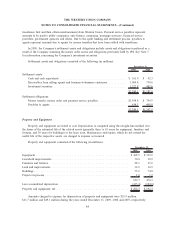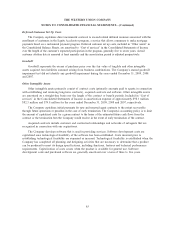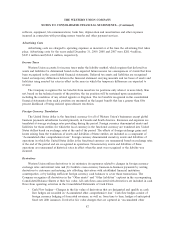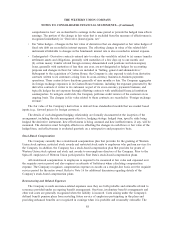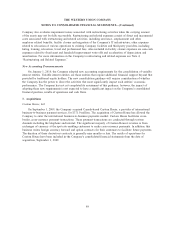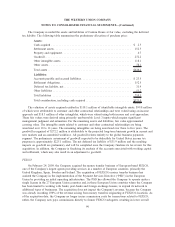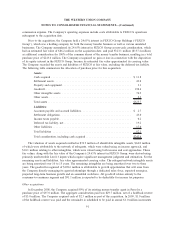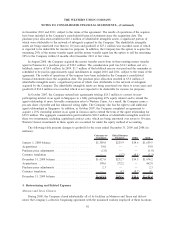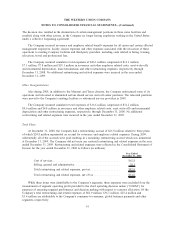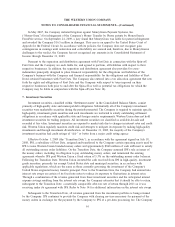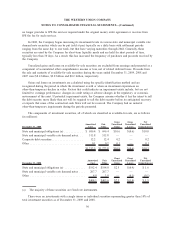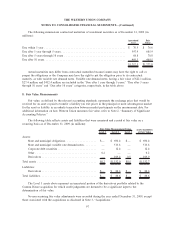Western Union 2009 Annual Report Download - page 102
Download and view the complete annual report
Please find page 102 of the 2009 Western Union annual report below. You can navigate through the pages in the report by either clicking on the pages listed below, or by using the keyword search tool below to find specific information within the annual report.comprehensive loss” are reclassified to earnings in the same period or periods the hedged item affects
earnings. The portion of the change in fair value that is excluded from the measure of effectiveness is
recognized immediately in “Derivative (losses)/gains, net.”
• Fair Value hedges—Changes in the fair value of derivatives that are designated as fair value hedges of
fixed rate debt are recorded in interest expense. The offsetting change in value of the related debt
instrument attributable to changes in the benchmark interest rate is also recorded in interest expense.
• Undesignated—Derivative contracts entered into to reduce the variability related to (a) money transfer
settlement assets and obligations, generally with maturities of a few days up to one month, and
(b) certain money transfer related foreign currency denominated cash positions and intercompany
loans, generally with maturities of less than one year, are not designated as hedges for accounting
purposes and changes in their fair value are included in “Selling, general and administrative.”
Subsequent to the acquisition of Custom House, the Company is also exposed to risk from derivative
contracts written to its customers arising from its cross-currency business-to-business payments
operations. These contracts have durations generally of nine months or less. The Company aggregates
its foreign exchange exposures in its Custom House business, including the exposure generated by the
derivative contracts it writes to its customers as part of its cross-currency payments business, and
typically hedges the net exposure through offsetting contracts with established financial institution
counterparties. To mitigate credit risk, the Company performs credit reviews of the customer on an
ongoing basis. The changes in fair value related to these contracts are recorded in “Foreign exchange
revenue.”
The fair value of the Company’s derivatives is derived from standardized models that use market based
inputs (e.g., forward prices for foreign currency).
The details of each designated hedging relationship are formally documented at the inception of the
arrangement, including the risk management objective, hedging strategy, hedged item, specific risks being
hedged, the derivative instrument, how effectiveness is being assessed and how ineffectiveness, if any, will be
measured. The derivative must be highly effective in offsetting the changes in cash flows or fair value of the
hedged item, and effectiveness is evaluated quarterly on a retrospective and prospective basis.
Stock-Based Compensation
The Company currently has a stock-based compensation plan that provides for the granting of Western
Union stock options, restricted stock awards and restricted stock units to employees who perform services for
the Company. In addition, the Company has a stock-based compensation plan that provides for grants of
Western Union stock options and stock unit awards to non-employee directors of the Company. Prior to the
Spin-off, employees of Western Union participated in First Data’s stock-based compensation plans.
All stock-based compensation to employees is required to be measured at fair value and expensed over
the requisite service period and also requires an estimate of forfeitures when calculating compensation
expense. The Company recognizes compensation expense on awards on a straight-line basis over the requisite
service period for the entire award. Refer to Note 16 for additional discussion regarding details of the
Company’s stock-based compensation plans.
Restructuring and Related Expenses
The Company records severance-related expenses once they are both probable and estimable related to
severance provided under an ongoing benefit arrangement. One-time, involuntary benefit arrangements and
other exit costs are generally recognized when the liability is incurred. Costs arising under the Company’s
defined benefit pension plans from curtailing future service of employees participating in the plans and
providing enhanced benefits are recognized in earnings when it is probable and reasonably estimable. The
88
THE WESTERN UNION COMPANY
NOTES TO CONSOLIDATED FINANCIAL STATEMENTS—(Continued)


